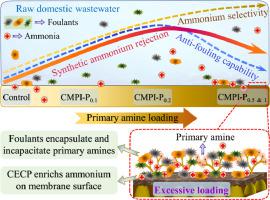Water Research ( IF 11.4 ) Pub Date : 2020-11-26 , DOI: 10.1016/j.watres.2020.116678 Xian Bao , Qianhong She , Wei Long , Qinglian Wu

|
Membrane fouling and ammonium transmembrane diffusion simultaneously pose great challenges in membrane-based pre-concentration of domestic wastewater for efficient subsequent resources recovery (i.e., energy and nutrients). Herein, amine-functionalized osmotic membranes were fabricated by optimizing the grafting pathway of polyamidoamine (PAMAM) dendrimer to mitigate fouling and ammonium transmembrane diffusion. Compared to the control membrane, the PAMAM-grafted membranes with abundant primary amine groups possessed substantially increased hydrophilicity and positive charges (i.e., protonated primary amines) and thus exhibited superior anti-fouling capability and ammonium selectivity. With further increasing the PAMAM grafting ratio, the membrane exhibited a steady enhancement in ammonium selectivity and eventually achieved an ultra-high ammonium rejection of 99.4%. Nevertheless, the anti-fouling capability of such ammonium ultra-selective membrane was weakened due to the suppression of the adverse impact of excessive positive charges over the beneficial effect of increased surface hydrophilicity. This in turn leads to a drop of ammonium rejection below 90% during domestic wastewater concentration. This study demonstrates that the membrane with a moderate primary amine loading could achieve the highest anti-fouling capability with only less than 10% flux decline and meanwhile maintain an excellent ammonium rejection above 94% during raw domestic wastewater concentration. This work provides theoretical guidance for fabricating simultaneously enhanced anti-fouling and ammonia-rejecting membranes.
中文翻译:

用于废水处理和营养富集的铵超选择性膜:表面电荷和亲水性对结垢倾向和铵排斥的相互作用
膜污染和铵跨膜扩散同时对基于膜的预浓缩生活废水提出了巨大挑战,以有效地进行后续资源回收(即能源和养分)。本文中,通过优化聚酰胺酰胺(PAMAM)树枝状大分子的接枝途径来减轻结垢和铵跨膜扩散,制备了胺官能化的渗透膜。与对照相比,膜,具有1.09×10丰富伯胺基团装载PAMAM-接枝膜6个/μm 2具有显着增加的亲水性和正电荷(即质子化的伯胺),因此显示出优异的防污能力和铵选择性。随着进一步增加PAMAM接枝率,膜中选择性铵显示出一个稳定的增强,并最终实现排斥为1.36×10伯胺基团装载99.4%的超高铵6个/μm 2。然而,由于抑制了过量正电荷的不利影响,而不是增加表面亲水性的有益效果,这种铵超选择性膜的防污能力被削弱。反过来,在生活污水浓缩过程中,氨截留率下降到90%以下。这项研究表明,具有中等伯胺负载量的膜可以实现最高的防污能力,通量下降仅不到10%,同时在生活污水原液浓缩期间,氨截留率保持在94%以上。这项工作为同时制造增强的防污膜和排氨膜提供了理论指导。











































 京公网安备 11010802027423号
京公网安备 11010802027423号